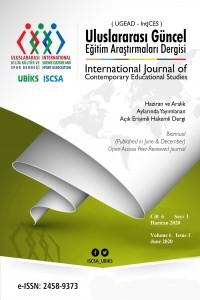İngilizce Öğretiminde Deyimsel İfadelerin Öğretiminin Gerekliliğine İlişkin Görüşlerin İncelenmesi
Bu çalışmanın amacı Batı Karadeniz Bölgesi’nde yer alan bir devlet üniversitesinin yabancı
Anahtar Kelimeler:
deyim; İngilizce; ihtiyaç analizi; hazırlık sınıfı
___
- Abisamra S N (2002). Teaching Idioms. http://abisamra02.tripod.com/idioms adresinden erişilmiştir.
- Akkök E A (2011). Yabancı Dilde Deyimlerin Öğretimi. Dil Dergisi, 143, 59-77
- Aksan D (2000). Her Yönüyle Dil: Ana Çizgileriyle Dilbilim. Ankara: Türk Dil Kurumu Yayınları.
- Aksoy Ö A (1988). Atasözleri ve Deyimler Sözlüğü. İstanbul: İnkılâp Kitapevi Yayınları.
- Andreou G, Galantomos L (2007). Designing a Conceptual Syllabus For Teaching Metaphors And Idioms in A Foreign Language Context. Porta Linguarum, (9):69-77.
- Angel R D (2016). Learners’ Beliefs about the Notion of Idiom. English Linguistics Research, 5(3),62-71.
- Asl F M (2013). The impact of Context on Learning Idioms in EFL Classes. TESOL Journal, 37(1), 1-12.
- Bateni M (2010). Collocations and Idioms and Their Translatability. Iranian Studies, 43(5),591-597.
- Bulut T (2004). Idiom Processing in L2: Through Rose-colored Glasses. The Reading Matrix, 4(2),105- 116.
- Burke D (1998). Without Slang and Idioms, Students Are “In the Dark!”. ESL Magazine, 1(5),20 – 23.
- Büyüköztürk Ş, Kılıç Çakmak E, Akgün Ö E, Karadeniz Ş, Demirel F (2010). Bilimsel Araştırma Yöntemleri (5. Baskı). Ankara: Pegem A Yayıncılık.
- Chuang Y (2013). A Study Of The Relationship Between College EFL Learners’ Vocabulary Size And Idiomatic Reading Comprehension. NCUE Journal of Humanities, 7, 59-76.
- Cooper C (1998). Teaching Idioms. Foreign Language Annals, 31 (2), 255 – 266.
- Cooper T (2012). Processing of Idioms by L2 Learners of English. TESOL Quarterly, (33)2,233-262.
- Creswell J W (2013). Nitel Araştırma Yöntemleri; Beş Yaklaşıma Göre Nitel Araştırma ve Araştırma Deseni (M. Bütün ve S. B. Demir, Çev.). Ankara: Siyasal Kitapevi.
- Çakir I (2011). How do Learners Perceive Idioms in EFL Classes? Ekev Akademi Dergisi, 15(47), 371-381.
- Delisle J (2001). Çeviri Yöntemleri İçin Söylem Çözümlemesi, (Çev. J. Umran Derkunt). İstanbul: Marmara Üniversitesi Yayınları.
- Eltahir R (2003). Teaching and Learning Of Idiomatic Expressions And Multiword Verbs Of English in The Context Of Sudan. Doktora Tezi. Hyderabad: University of Hyderabad.
- Güneş S (2009). Yabancı Dil Öğretiminde Deyim Öğretimi: Yöntemler, Teknikler ve Uygulamalar. Dilbilim, 2 (2), 1-15.
- Liontas J I (2002). Exploring Second Language Learners' Notions Of Idiomaticity. System, 30 (3), 289-313.
- Mahmoud A (2002). Interlingual Transfer of Idioms by Arab Learners of English. I-TESL-Journal, 8(12), 1-5.
- Maisa S, & Karunakaran T (2013). Idioms and Importance of Teaching Idioms to ESL Students: A Study on Teacher Beliefs. Asian Journal of Humanities and Social Sciences, 1(1), 1-13.
- Merriam-Webster’s Dictionary (2018). https://www.merriam-webster.com/dictionary/idiom adresinden erişilmiştir.
- Najarzadegan S, Ketabi S (2015). Teachers’ Beliefs about Teaching Idiomatic Expressions: The Case of Iranian EFL Learners. Journal of Applied Linguistics and Language Research, 2 (3), 120-132.
- Nippold M (2003). Mental Imagery and Idioms Comprehension: A Comparison of School-age Children and Adults. Journal of Speech, Language and Hearing Research, 46(4),788-799.
- Noor H, Fallatah M (2010). An Investigation of Some Difficulties in Idioms Encountered by Saudi Learners of English. International Journal of Arabic-English Studies, 1, 147-174.
- Palmer F R (2001). Semantik: Yeni bir Anlambilim Projesi.(Çev. R. Ertürk). Ankara: Kitabiyat Yayınevi.
- Tarcaoanu M C (2012). Teaching and Learning Idioms in English (Theoretical and Practical Considerations). Scientific Journal of Humanistic Studies, 4(7), 220-228.
- Yavuz N (2010). Yabancı Dilde Deyimlerin Öğretimi İçin Bir Araç Geliştirme Denemesi. Dil Dergisi. 147, 7-21
- Yıldırım A, Şimşek H (2006). Sosyal Bilimlerde Nitel Araştırma Yöntemleri. Ankara: Seçkin Yayınları.
- Başlangıç: 2015
- Yayıncı: Uluslararası Bilim Kültür ve Spor Derneği (UBİKS)
Sayıdaki Diğer Makaleler
İngilizce Öğretiminde Deyimsel İfadelerin Öğretiminin Gerekliliğine İlişkin Görüşlerin İncelenmesi
Orhan ATAMAN, Abdurrahman KILIÇ
Muay-Thai Antrenörlerinin Liderlik Stillerinin Farklı Değişkenlere Göre İncelenmesi
Korkmaz ATALAY, Ender EYUBOĞLU, Aydın ŞENTÜRK
Taner BOZKUŞ, Mine TURĞUT, Hacı Murat ŞAHİN, Mücahit OKUYUCU
